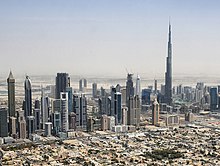 Dubai, the financial center of the United Arab Emirates | |
| Currency | Emirati dirham (AED, د.إ) |
|---|---|
| US$1 = 3.6725 AED | |
| Calendar year | |
Trade organisations | OPEC, WTO, GCC, BRICS |
Country group |
|
| Statistics | |
| Population | |
| GDP | |
| GDP rank | |
GDP growth | |
GDP per capita | |
GDP per capita rank | |
GDP by sector |
|
Population below poverty line | N/A |
| 26.0 low (2018)[7] | |
| |
Labour force | |
Labour force by occupation |
|
| Unemployment | |
Main industries | |
| External | |
| Exports | |
Export goods | Crude oil, refined petroleum, gold, reexports, telecommunications equipment, diamonds, petroleum gas, jewellery, aluminium (2021)[12] |
Main export partners | |
| Imports | |
Import goods | Gold, food, machinery, transport vehicles and parts, refined petroleum, natural gas, diamonds, jewellery, refined copper (2021)[12] |
Main import partners |
|
FDI stock | |
Gross external debt | |
| Public finances | |
| −0.2% (of GDP) (2017 est.)[6] | |
| Revenues | 15.79 billion (2021 est.)[6] |
| Expenses | 16.6 billion (2021 est.)[6][note 1] |
| Standard & Poor's: AA[14] Outlook: Stable Moody's: Aa2 Outlook: Stable Fitch: AA Outlook: Stable | |
All values, unless otherwise stated, are in US dollars. | |
The United Arab Emirates is a high-income developing market economy. The UAE's economy is the 4th largest in the Middle East (after Turkey, Saudi Arabia and Israel), with a gross domestic product (GDP) of US$415 billion (AED 1.83 trillion) in 2021-2023.[5]
The UAE economy is heavily reliant on revenues from petroleum and natural gas, especially in Abu Dhabi. In 2009, more than 85% of the UAE's economy was based on the oil exports.[15][16] In 2011, oil exports accounted for 77% of the UAE's state budget.[17] In recent years, there has been some economic diversification,[18] particularly in Dubai.[19] Abu Dhabi and other UAE emirates have remained relatively conservative in their approach to diversification. Dubai has far smaller oil reserves than its counterparts.[20]
Tourism is one of the biggest non-oil sources of revenue in the UAE. A massive construction boom, an expanding manufacturing base, and a thriving services sector are helping the country to diversify its economy. Nationwide, there is currently US $350 billion worth of active construction projects.[21]
The UAE is a member of the World Trade Organization and OPEC.
- ^ "World Economic Outlook Database Groups and Aggregates Information". International Monetary Fund.
- ^ "World Bank Country and Lending Groups". datahelpdesk.worldbank.org. World Bank. Archived from the original on 28 October 2019. Retrieved 29 September 2019.
- ^ "united-arab-emirates". The World Factbook (2024 ed.). Central Intelligence Agency.
- ^ "Population, total". data.worldbank.org. World Bank. Archived from the original on 24 August 2019. Retrieved 24 August 2019.
- ^ a b c d e f g h i "Report for Selected Countries and Subjects: October 2024". imf.org. International Monetary Fund.
- ^ a b c d e f g h i j k l m n "The World Factbook". CIA.gov. Central Intelligence Agency. Archived from the original on 7 January 2022. Retrieved 13 June 2019.
- ^ "GINI index (World Bank estimate) – United Arab Emirates". data.worldbank.org. World Bank. Archived from the original on 30 March 2020. Retrieved 30 March 2020.
- ^ a b "Human Development Report 2023/2024" (PDF). United Nations Development Programme. 13 March 2024. Archived (PDF) from the original on 13 March 2024. Retrieved 15 June 2024.
- ^ "Labor force, total - United Arab Emirates". data.worldbank.org.
- ^ "Employment to population ratio, 15+, total (%) (national estimate)". data.worldbank.org. World Bank. Archived from the original on 24 August 2019. Retrieved 24 August 2019.
- ^ "Unemployment, total (% of total labor force) (national estimate)". data.worldbank.org. World Bank. Archived from the original on 7 January 2022. Retrieved 24 August 2019.
- ^ a b c "Export Partners of United Arab Emirates". The Observatory of Economic Complexity. Retrieved 7 April 2023.
- ^ "Import Partners of United Arab Emirates". The Observatory of Economic Complexity. Retrieved 7 April 2023.
- ^ "Sovereigns rating list". Standard & Poor's. Archived from the original on 26 June 2015. Retrieved 26 May 2011.
- ^ "The World Factbook". CIA. 12 January 2022. Archived from the original on 7 January 2022. Retrieved 20 February 2023.
- ^ "WTO Trade Statistic 2009". Stat.wto.org. Archived from the original on 4 March 2016. Retrieved 1 December 2014.
- ^ "Economic diversification in the GCC countries" (PDF). January 2013. p. 13. Archived from the original (PDF) on 5 December 2014. Retrieved 1 December 2014.
- ^ Kader, Binsal Abdul (20 April 2011). "Diversification raises non-oil share of UAE's GDP to 71%". Archived from the original on 1 March 2014. Retrieved 20 February 2023.
- ^ "Dubai Model of Economic Diversification and Development" (PDF).
- ^ "United Arab Emirates profile". BBC News. 14 November 2012. Archived from the original on 27 November 2020. Retrieved 20 February 2023.
- ^ 3 Archived 2009-06-04 at the Wayback Machine
Cite error: There are <ref group=note> tags on this page, but the references will not show without a {{reflist|group=note}} template (see the help page).